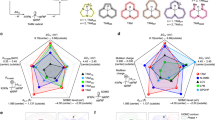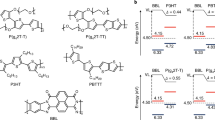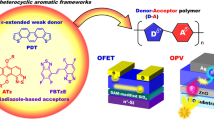Abstract
The development of n-type organic thermoelectrics (OTEs) falls significantly behind that of their p-type counterparts. Herein, two acceptor-acceptor (A-A) polymers, PDCNBT-DPP and PDCNBSe-DPP, were generated by combining strongly electron-deficient cyano-functionalized benzochalcogenadiazole and diketopyrrolopyrrole building blocks, both of which acted as universal moieties for high-mobility polymers. The A-A polymers showed good solubility, low-lying lowest unoccupied molecular orbital (LUMO) energy levels, and narrow bandgaps; thus, predominant n-type characteristics were achieved in organic thin-film transistors. After n-type doping, both polymers exhibited n-type performance, in which the highest conductivity was 12.36 S cm−1 and a large power factor of 9.22 μW m−1 K−2 was obtained in OTE devices. Our study demonstrated that benzochalcogenadiazole is an excellent building block for developing n-type OTE materials. In addition, the A-A strategy provides an avenue for constructing new types of polymers for high-power n-type OTE materials.
This is a preview of subscription content, access via your institution
Access options
Subscribe to this journal
Receive 12 print issues and online access
$259.00 per year
only $21.58 per issue
Buy this article
- Purchase on Springer Link
- Instant access to full article PDF
Prices may be subject to local taxes which are calculated during checkout







Similar content being viewed by others
References
Horowitz G. Organic semiconductors for new electronic devices. Adv Mater. 1990;2:287–92. https://doi.org/10.1002/adma.19900020604
Heeger AJ. Semiconducting polymers: The third generation. Chem Soc Rev. 2010;39:2354–71. https://doi.org/10.1039/B914956M
Wang C, Dong H, Hu W, Liu Y, Zhu D. Semiconducting π-conjugated systems in field-effect transistors: A material odyssey of organic electronics. Chem Rev. 2012;112:2208–67. https://doi.org/10.1021/cr100380z.
Russ B, Glaudell A, Urban JJ, Chabinyc ML, Segalman RA. Organic thermoelectric materials for energy harvesting and temperature control. Nat Rev Mater. 2016;1:16050 https://doi.org/10.1038/natrevmats.2016.50
McGrail BT, Sehirlioglu A, Pentzer E. Polymer composites for thermoelectric applications. Angew Chem Int Ed. 2015;54:1710–23. https://doi.org/10.1002/anie.201408431
He M, Qiu F, Lin Z. Towards high-performance polymer-based thermoelectric materials. Energy Environ Sci. 2013;6:1352–61. https://doi.org/10.1039/C3EE24193A
Chen Y, Zhao Y, Liang Z. Solution processed organic thermoelectrics: Towards flexible thermoelectric modules. Energy Environ Sci. 2015;8:401–22. https://doi.org/10.1039/C4EE03297G
Bubnova O, Crispin X. Towards polymer-based organic thermoelectric generators. Energy Environ Sci. 2012;5:9345–62. https://doi.org/10.1039/C2EE22777K
Zhao D, Fabiano S, Berggren M, Crispin X. Ionic thermoelectric gating organic transistors. Nat Commun. 2017;8:14214 https://doi.org/10.1038/ncomms14214
Hata S, Tomotsu J, Gotsubo M, Du Y, Shiraishi Y, Toshima N. N-type carbon nanotube sheets for high in-plane ZT values in double-doped electron-donating graft copolymers containing diphenylhydrazines. Polym J. 2021;53:1281–6. https://doi.org/10.1038/s41428-021-00519-6
Fan Z, Li P, Du D, Ouyang J. Significantly enhanced thermoelectric properties of PEDOT:PSS films through sequential post-treatments with common acids and bases. Adv Energy Mater. 2017;7:1602116 https://doi.org/10.1002/aenm.201602116
Wang X, Zhang X, Sun L, Lee D, Lee S, Wang M, et al. High electrical conductivity and carrier mobility in oCVD PEDOT thin films by engineered crystallization and acid treatment. Sci Adv. 2018;4:eaat5780 https://doi.org/10.1126/sciadv.aat5780
Patel SN, Glaudell AM, Kiefer D, Chabinyc ML. Increasing the thermoelectric power factor of a semiconducting polymer by doping from the vapor phase. ACS Macro Lett. 2016;5:268–72. https://doi.org/10.1021/acsmacrolett.5b00887
Bubnova O, Berggren M, Crispin X. Tuning the thermoelectric properties of conducting polymers in an electrochemical transistor. J Am Chem Soc. 2012;134:16456–9. https://doi.org/10.1021/ja305188r
Kim GH, Shao L, Zhang K, Pipe KP. Engineered doping of organic semiconductors for enhanced thermoelectric efficiency. Nat Mater. 2013;12:719–23. https://doi.org/10.1038/nmat3635
Xia Y, Sun K, Ouyang J. Solution-processed metallic conducting polymer films as transparent electrode of optoelectronic devices. Adv Mater. 2012;24:2436–40. https://doi.org/10.1002/adma.201104795
Liu J, Shi Y, Dong J, Nugraha MI, Qiu X, Su M, et al. Overcoming coulomb interaction improves free-charge generation and thermoelectric properties for n-doped conjugated polymers. ACS Energy Lett. 2019;4:1556–64. https://doi.org/10.1021/acsenergylett.9b00977
Yan X, Xiong M, Li J-T, Zhang S, Ahmad Z, Lu Y, et al. Pyrazine-flanked diketopyrrolopyrrole (DPP): A new polymer building block for high-performance n-type organic thermoelectrics. J Am Chem Soc. 2019;141:20215–21. https://doi.org/10.1021/jacs.9b10107
Lu Y, Yu Z-D, Zhang R-Z, Yao Z-F, You H-Y, Jiang L, et al. Rigid coplanar polymers for stable n-type polymer thermoelectrics. Angew Chem Int Ed 2019;58:11390–4.
Wang S, Sun H, Erdmann T, Wang G, Fazzi D, Lappan U, et al. A chemically doped naphthalenediimide-bithiazole polymer for n-type organic thermoelectrics. Adv Mater. 2018;30:1801898 https://doi.org/10.1002/adma.201801898
Yang C-Y, Jin W-L, Wang J, Ding Y-F, Nong S, Shi K, et al. Enhancing the n-type conductivity and thermoelectric performance of donor–acceptor copolymers through donor engineering. Adv Mater. 2018;30:1802850 https://doi.org/10.1002/adma.201802850
Liu J, Ye G, Zee BVD, Dong J, Qiu X, Liu Y, et al. N-type organic thermoelectrics of donor–acceptor copolymers: Improved power factor by molecular tailoring of the density of states. Adv Mater. 2018;30:1804290 https://doi.org/10.1002/adma.201804290
Lu Y, Wang J-Y, Pei J. Strategies to enhance the conductivity of n-type polymer thermoelectric materials. Chem Mater. 2019;31:6412–23. https://doi.org/10.1021/acs.chemmater.9b01422
Wang S, Fazzi D, Puttisong Y, Jafari MJ, Chen Z, Ederth T, et al. Effect of backbone regiochemistry on conductivity, charge density, and polaron structure of n-doped donor–acceptor polymers. Chem Mater. 2019;31:3395–406. https://doi.org/10.1021/acs.chemmater.9b00558
Gross YM, Trefz D, Dingler C, Bauer D, Vijayakumar V, Untilova V, et al. From isotropic to anisotropic conductivities in p(ndi2od-t2) by (electro-)chemical doping strategies. Chem Mater. 2019;31:3542–55. https://doi.org/10.1021/acs.chemmater.9b00977
Naab BD, Gu X, Kurosawa T, To JWF, Salleo A, Bao Z. Role of polymer structure on the conductivity of n-doped polymers. Adv Electron Mater. 2016;2:1600004 https://doi.org/10.1002/aelm.201600004
Tripathi A, Lee Y, Lee S, Woo HY. Recent advances in n-type organic thermoelectric materials, dopants, and doping strategies. J Mater Chem C. 2022;10:6114–40. https://doi.org/10.1039/D1TC06175E
Lu Y, Yu Z-D, Un H-I, Yao Z-F, You H-Y, Jin W, et al. Persistent conjugated backbone and disordered lamellar packing impart polymers with efficient n-doping and high conductivities. Adv Mater. 2021;33:2005946 https://doi.org/10.1002/adma.202005946
Guo H, Yang C-Y, Zhang X, Motta A, Feng K, Xia Y, et al. Transition metal-catalysed molecular n-doping of organic semiconductors. Nature. 2021;599:67–73. https://doi.org/10.1038/s41586-021-03942-0
Guo K, Bai J, Jiang Y, Wang Z, Sui Y, Deng Y, et al. Diketopyrrolopyrrole-based conjugated polymers synthesized via direct arylation polycondensation for high mobility pure n-channel organic field-effect transistors. Adv Funct Mater. 2018;28:1801097 https://doi.org/10.1002/adfm.201801097
Nielsen CB, Turbiez M, McCulloch I. Recent advances in the development of semiconducting DPP-containing polymers for transistor applications. Adv Mater. 2013;25:1859–80. https://doi.org/10.1002/adma.201201795
Chandran D, Lee K-S. Diketopyrrolopyrrole: A versatile building block for organic photovoltaic materials. Macromol Res. 2013;21:272–83. https://doi.org/10.1007/s13233-013-1141-3
Park JH, Jung EH, Jung JW, Jo WH. A fluorinated phenylene unit as a building block for high-performance n-type semiconducting polymer. Adv Mater. 2013;25:2583–8. https://doi.org/10.1002/adma.201205320
Liu Q, He W, Shi Y, Otep S, Tan WL, Manzhos S, et al. Directional carrier polarity tunability in ambipolar organic transistors based on diketopyrrolopyrrole and bithiophene imide dual-acceptor semiconducting polymers. Chem Mater. 2022;34:3140–51. https://doi.org/10.1021/acs.chemmater.1c04258
Shi S, Wang H, Chen P, Uddin MA, Wang Y, Tang Y, et al. Cyano-substituted benzochalcogenadiazole-based polymer semiconductors for balanced ambipolar organic thin-film transistors. Polym Chem. 2018;9:3873–84. https://doi.org/10.1039/C8PY00540K
Feng K, Huang J, Zhang X, Wu Z, Shi S, Thomsen L, et al. High-performance all-polymer solar cells enabled by n-type polymers with an ultranarrow bandgap down to 1.28 ev. Adv Mater. 2020;32:2001476 https://doi.org/10.1002/adma.202001476
Kumsampao J, Chaiwai C, Chasing P, Chawanpunyawat T, Namuangruk S, Sudyoadsuk T, et al. A simple and strong electron-deficient 5,6-dicyano[2,1,3]benzothiadiazole-cored donor-acceptor-donor compound for efficient near infrared thermally activated delayed fluorescence. Chem Asian J. 2020;15:3029–36. https://doi.org/10.1002/asia.202000727
Park KH, Go J-Y, Lim B, Noh Y-Y. Recent progress in lactam-based polymer semiconductors for organic electronic devices. J Polym Sci. 2022;60:429–85. https://doi.org/10.1002/pol.20210625
Zhao W, Ding J, Zou Y, Di C-A, Zhu D. Chemical doping of organic semiconductors for thermoelectric applications. Chem Soc Rev. 2020;49:7210–28. https://doi.org/10.1039/D0CS00204F
Di Pietro R, Erdmann T, Carpenter JH, Wang N, Shivhare RR, Formanek P, et al. Synthesis of high-crystallinity DPP polymers with balanced electron and hole mobility. Chem Mater. 2017;29:10220–32. https://doi.org/10.1021/acs.chemmater.7b04423
Zhang A, Xiao C, Wu Y, Li C, Ji Y, Li L, et al. Effect of fluorination on molecular orientation of conjugated polymers in high performance field-effect transistors. Macromolecules. 2016;49:6431–8. https://doi.org/10.1021/acs.macromol.6b01446
Kang I, Yun H-J, Chung DS, Kwon S-K, Kim Y-H. Record high hole mobility in polymer semiconductors via side-chain engineering. J Am Chem Soc. 2013;135:14896–9. https://doi.org/10.1021/ja405112s
Gao Y, Bai J, Sui Y, Han Y, Deng Y, Tian H, et al. High mobility ambipolar diketopyrrolopyrrole-based conjugated polymers synthesized via direct arylation polycondensation: Influence of thiophene moieties and side chains. Macromolecules. 2018;51:8752–60. https://doi.org/10.1021/acs.macromol.8b01112
Shi S, Chen P, Chen Y, Feng K, Liu B, Chen J, et al. A narrow-bandgap n-type polymer semiconductor enabling efficient all-polymer solar cells. Adv Mater. 2019;31:1905161 https://doi.org/10.1002/adma.201905161
Acknowledgements
X.G. is thankful for the financial support from the Songshan Lake Materials Laboratory (2021SLABFK03) and the Guangdong Provincial Key Laboratory Program (2021B1212040001) from the Department of Science and Technology of Guangdong Province. K.F acknowledges the financial support from the Guangdong Basic and Applied Basic Research Foundation (2021A1515011640), the Shenzhen Basic Research Fund (no. JCYJ20190809162003662) and the National Natural Science Foundation of China (22005135). This work is also supported by the Center for Computational Science and Engineering at Southern University of Science and Technology (SUSTech). The authors acknowledge the assistance of the SUSTech Core Research Facilities.
Author information
Authors and Affiliations
Contributions
J.W. and K.F. contributed equally to this work.
Corresponding authors
Ethics declarations
Conflict of interest
The authors declare no competing interests.
Additional information
Publisher’s note Springer Nature remains neutral with regard to jurisdictional claims in published maps and institutional affiliations.
Supplementary information
Rights and permissions
Springer Nature or its licensor holds exclusive rights to this article under a publishing agreement with the author(s) or other rightsholder(s); author self-archiving of the accepted manuscript version of this article is solely governed by the terms of such publishing agreement and applicable law.
About this article
Cite this article
Wang, J., Feng, K., Jeong, S.Y. et al. Acceptor-acceptor type polymers based on cyano-substituted benzochalcogenadiazole and diketopyrrolopyrrole for high-efficiency n-type organic thermoelectrics. Polym J 55, 507–515 (2023). https://doi.org/10.1038/s41428-022-00717-w
Received:
Revised:
Accepted:
Published:
Issue Date:
DOI: https://doi.org/10.1038/s41428-022-00717-w



